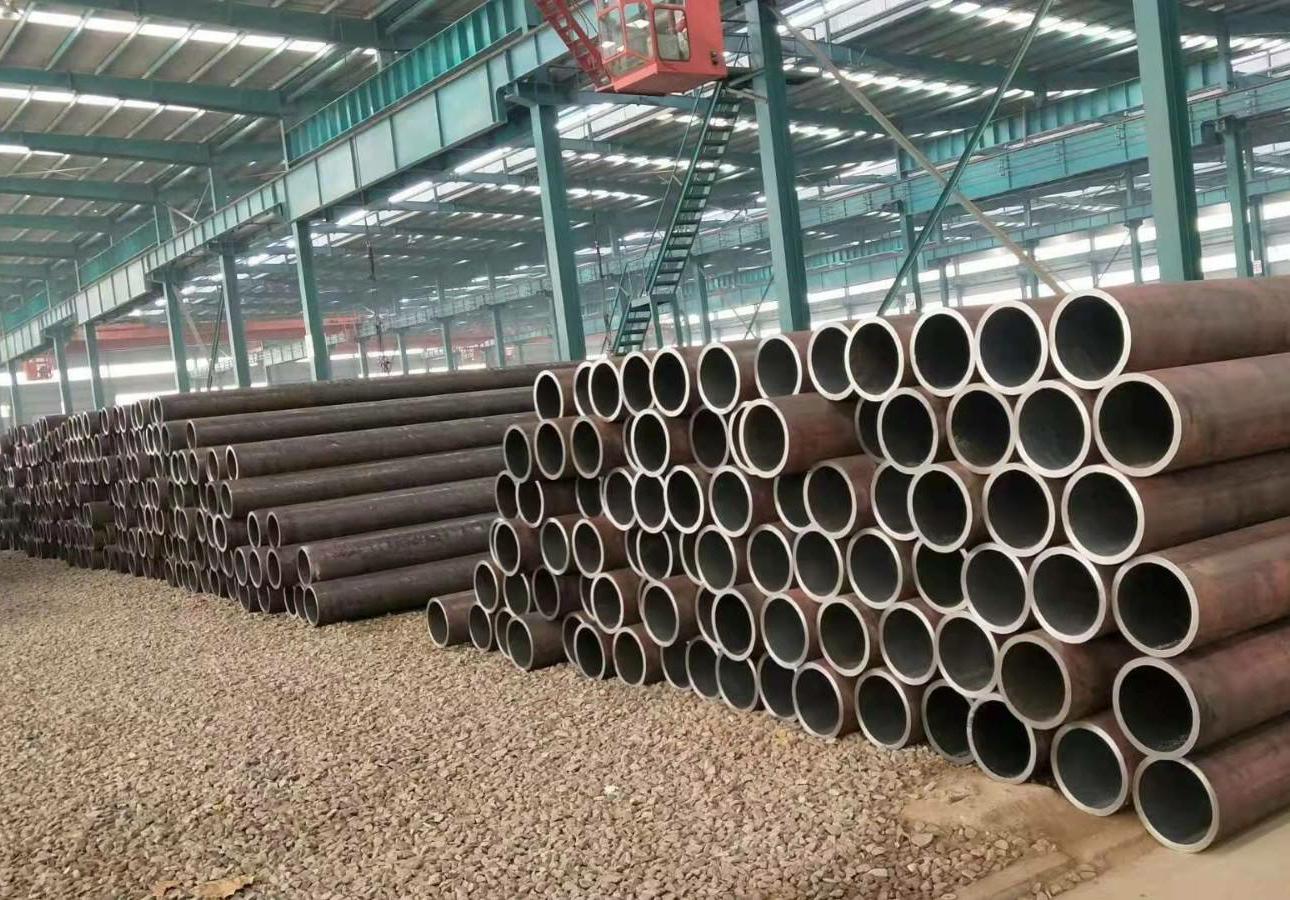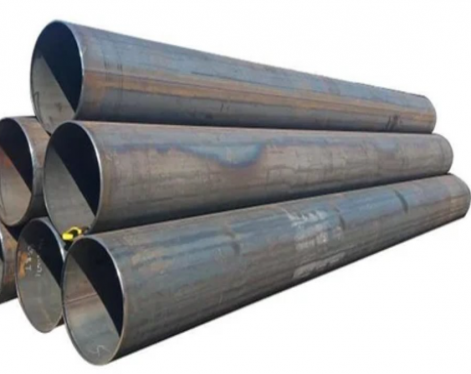The cross-rolling process of seamless pipes is a rolling process in which the rolled piece rotates along its own axis, deforms, and advances between two or three rolls with the same rotation direction and intersecting (or inclined) longitudinal axes.
Cross rolling is a rolling method between longitudinal rolling and cross rolling. Cross rolling is mainly used for piercing and rolling of pipes (seamless pipe production) and periodic section rolling of steel balls.
There are 3 types of skew rolling forming:
(1) Cross rolling applied in the production of seamless steel pipes, including cross rolling piercing, cross rolling extension, leveling and cross rolling sizing (see sizing);
(2) Pass-shaped skew rolling, which is characterized by rolling grooves with variable height and variable pitch on the surface of the roll, which can roll out rotary products with variable cross-sections in length, such as steel ball rolling, screw rolling, etc.;
(3) Profile skew rolling, which controls three rotating conical rolls by means of a hydraulic or mechanical profile plate, and performs radial movement relative to the center of the rolled piece to complete the rolling of the variable-section axis. Profile cross rolling is mainly used to produce relatively long variable-section shaft products, such as textile spindles, knives and scissors, surgical instruments and other blanks.
The cross rolling method has been widely used in the production process of thermal expansion seamless steel pipes. In addition to its application in the main thermal expansion process of piercing, it is also used in basic processes such as tube rolling, leveling, sizing, extension, diameter expansion and spinning. The difference between cross rolling and longitudinal rolling and cross rolling is mainly in the fluidity of metal.The main direction of metal flow in longitudinal rolling is the same as that of the roll surface, and the main direction of metal flow in cross rolling is the same as that of the roll surface. Cross rolling is located between longitudinal rolling and cross rolling. The flow direction of the deformed metal is at an angle to the direction of movement of the deformation tool roll. In addition to the forward movement, the metal also rotates around its own axis, which is a spiral forward movement. There are two types of skew rolling mills used in production: two-roll and three-roll systems.

The piercing process in the production of thermal expansion seamless steel pipe is more reasonable today, and the piercing process has been automated. The whole process of cross-rolling piercing can be divided into 3 stages:
1. Unstable process. The metal at the front end of the tube blank gradually fills the deformation zone stage, that is, the tube blank and the roll begin to contact the front metal and exit the deformation zone. In this stage, there are primary bite and secondary bite.
2. Stabilization process. This is the main stage of the piercing process, from the metal at the front end of the tube blank to the deformation zone until the metal at the tail end of the tube blank begins to leave the deformation zone.
3. Unstable process. The metal at the end of the tube blank gradually leaves the deformation zone until all the metal leaves the roll.
There is a clear difference between a stable process and an unstable process, which is easily observed in the production process. For example, there is a difference between the size of the head and tail and the middle size of a capillary. Generally, the diameter of the front end of the capillary is large, the diameter of the tail end is small, and the middle part is consistent. Large head-to-tail size deviation is one of the characteristics of an unstable process.The reason for the large diameter of the head is that the metal at the front end gradually fills the deformation zone, and the friction force on the contact surface between the metal and the roll increases gradually. The maximum value is reached in the complete deformation zone, especially when the front end of the tube blank meets the plug, due to the axial resistance of the plug, the metal is resisted in the axial extension, so that the axial extension deformation decreases, while the lateral deformation increases. Plus there is no outer end restriction, resulting in a large front diameter. The diameter of the tail end is small, because when the tail end of the tube blank is penetrated by the plug, the resistance of the plug drops significantly, and it is easy to extend and deform. At the same time, the lateral rolling is small, so the outer diameter is small.
Cross rolling is a rolling method between longitudinal rolling and cross rolling. Cross rolling is mainly used for piercing and rolling of pipes (seamless pipe production) and periodic section rolling of steel balls.
There are 3 types of skew rolling forming:
(1) Cross rolling applied in the production of seamless steel pipes, including cross rolling piercing, cross rolling extension, leveling and cross rolling sizing (see sizing);
(2) Pass-shaped skew rolling, which is characterized by rolling grooves with variable height and variable pitch on the surface of the roll, which can roll out rotary products with variable cross-sections in length, such as steel ball rolling, screw rolling, etc.;
(3) Profile skew rolling, which controls three rotating conical rolls by means of a hydraulic or mechanical profile plate, and performs radial movement relative to the center of the rolled piece to complete the rolling of the variable-section axis. Profile cross rolling is mainly used to produce relatively long variable-section shaft products, such as textile spindles, knives and scissors, surgical instruments and other blanks.
The cross rolling method has been widely used in the production process of thermal expansion seamless steel pipes. In addition to its application in the main thermal expansion process of piercing, it is also used in basic processes such as tube rolling, leveling, sizing, extension, diameter expansion and spinning. The difference between cross rolling and longitudinal rolling and cross rolling is mainly in the fluidity of metal.The main direction of metal flow in longitudinal rolling is the same as that of the roll surface, and the main direction of metal flow in cross rolling is the same as that of the roll surface. Cross rolling is located between longitudinal rolling and cross rolling. The flow direction of the deformed metal is at an angle to the direction of movement of the deformation tool roll. In addition to the forward movement, the metal also rotates around its own axis, which is a spiral forward movement. There are two types of skew rolling mills used in production: two-roll and three-roll systems.

The piercing process in the production of thermal expansion seamless steel pipe is more reasonable today, and the piercing process has been automated. The whole process of cross-rolling piercing can be divided into 3 stages:
1. Unstable process. The metal at the front end of the tube blank gradually fills the deformation zone stage, that is, the tube blank and the roll begin to contact the front metal and exit the deformation zone. In this stage, there are primary bite and secondary bite.
2. Stabilization process. This is the main stage of the piercing process, from the metal at the front end of the tube blank to the deformation zone until the metal at the tail end of the tube blank begins to leave the deformation zone.
3. Unstable process. The metal at the end of the tube blank gradually leaves the deformation zone until all the metal leaves the roll.
There is a clear difference between a stable process and an unstable process, which is easily observed in the production process. For example, there is a difference between the size of the head and tail and the middle size of a capillary. Generally, the diameter of the front end of the capillary is large, the diameter of the tail end is small, and the middle part is consistent. Large head-to-tail size deviation is one of the characteristics of an unstable process.The reason for the large diameter of the head is that the metal at the front end gradually fills the deformation zone, and the friction force on the contact surface between the metal and the roll increases gradually. The maximum value is reached in the complete deformation zone, especially when the front end of the tube blank meets the plug, due to the axial resistance of the plug, the metal is resisted in the axial extension, so that the axial extension deformation decreases, while the lateral deformation increases. Plus there is no outer end restriction, resulting in a large front diameter. The diameter of the tail end is small, because when the tail end of the tube blank is penetrated by the plug, the resistance of the plug drops significantly, and it is easy to extend and deform. At the same time, the lateral rolling is small, so the outer diameter is small.









